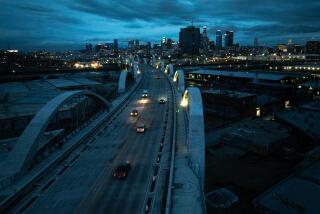Shakespeare Bridge’s New Life Celebrated
- Share via
Los Angeles may not be known for the breathtaking arched bridges that crown other major cities, but for more than 70 years, Los Feliz residents have carried on a love affair with the small crossing that spans a deep ravine near their hillside homes.
Topped with turrets and towers, the fanciful Shakespeare Bridge has been called the most romantic in Los Angeles. When the gothic-style bridge reopened Sunday after a year of earthquake renovation, residents celebrated not only the end of the retrofitting, but the preservation of the unique landmark.
“This bridge has a magical, fairy tale-like quality,” said Adam Weisman, president of the Franklin Hills Residents Assn., which sponsored Sunday’s party along with the city. “It’s our gateway to the hills.”
The celebration in Franklin Hills, a diverse community on the south end of Los Feliz, drew more than 1,000 residents to the narrow concrete bridge Sunday afternoon. They danced to swing music, many decked out in 1920s-era clothing to honor the decade when the automobile and pedestrian bridge was built.
“This is a very special bridge for us,” said resident Pebble Wilkins, clad in a black flapper dress with long strands of pearls. “We’re all very territorial about this community. It’s like our own little town, and this is a piece of our history.”
The Shakespeare Bridge reflects the local quality of Los Angeles spans and their role in shaping neighborhood identity, historians said.
“We’re a city of small bridges that connect neighborhoods to each other,” said Linda Dishman, executive director of the Los Angeles Conservancy. “We don’t have the need for a large bridge, but these smaller bridges provide a strong community link.”
Unlike the wide bridges that cross the Los Angeles River, the 260-foot-long, 30-foot-wide Shakespeare Bridge is known for its intimate feel, she said.
*
“It’s not a cookie-cutter bridge, just like this is not a cookie-cutter community,” said Bruce Carroll, who has lived in the area since 1970.
Originally known as the Franklin Avenue Bridge, the crossing was designed by city engineer J.C. Wright and completed in 1926 for $59,960. The thoroughfare provided the first connection between the east and west sides of a ravine and spawned residential development in the hilly neighborhood, which is known for its artists and entertainers.
From the beginning, the bridge was associated with the mystique of nearby Hollywood. Some called the crossing the Disney Bridge, after local resident Walt Disney. Cecil B. DeMille and silent screen actress Norma Talmadge also lived nearby, and film studios popped up in the area.
Part of the bridge’s romance is due to the mystery of its moniker. No one is sure why it came to be named after England’s bard, but in 1974, the city made the Shakespeare Bridge a historic cultural monument and the name stuck.
Locals speculate that the arches and turrets reminded neighbors of a structure out of Elizabethan times.
“It was called the Shakespeare Bridge as far back as I can remember, and I’ve been here 51 years,” said resident Rose Dee Tavella, 78. “I’m rather romantic and I love Shakespeare, so I guess I thought it was a copy from something in Stratford-upon-Avon.”
The Franklin Hills neighborhood grew up around the bridge, which was a popular spot. Tavella’s son Peter remembers slipping down to the bridge to smoke with friends after jam sessions with their 1960s rock band.
Many newer residents said they were drawn to the area because of the concrete crossing, which leads up to the red tile-roofed homes nestled in the hills.
When Sheri Mobley and her husband went house-hunting 10 years ago, they had never heard of Franklin Hills or the Shakespeare Bridge.
“For me, it was the selling point,” Mobley said. “We crossed this bridge, came up into the hills and it was part of the whole process of realizing, ‘Wow, this is a a great neighborhood.’ ”
Neighbors are protective of the bridge and its role in their community. When longtime resident Phillip Lyons noticed graffiti marking up the span 12 years ago, he immediately painted over the vandalism. Soon, Lyons was making rounds in the neighborhood with his buckets of paint, a self-proclaimed graffiti abater.
“It’s a nice neighborhood, with real neighborly people,” said Lyons, 70, who grew up in a house two blocks from the bridge.
He and others were relieved the yearlong earthquake renovation left the bridge’s historic beauty intact.
“It’s really the landmark that everyone coalesces around,” said resident Eugene Cheltenham. “This passageway indicates the origins of our community.”
More to Read
Sign up for Essential California
The most important California stories and recommendations in your inbox every morning.
You may occasionally receive promotional content from the Los Angeles Times.













